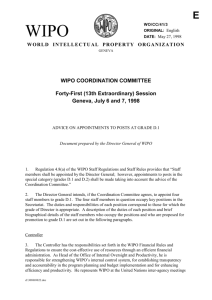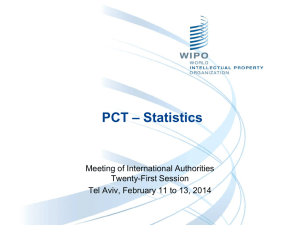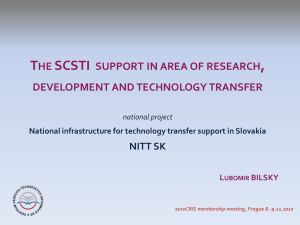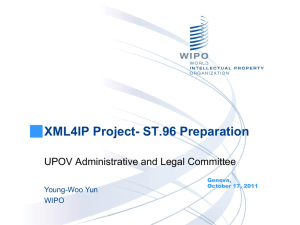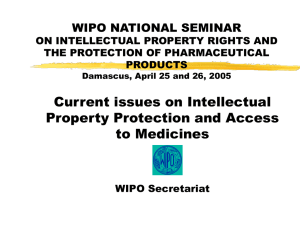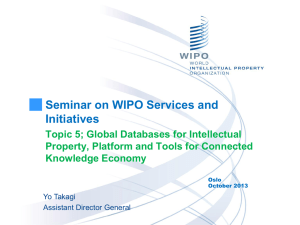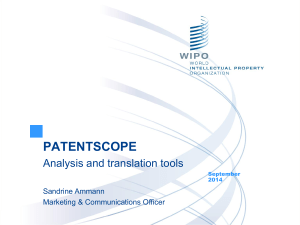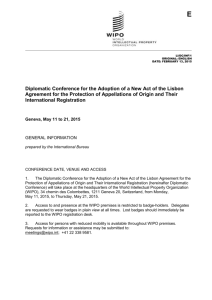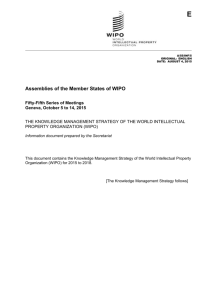“Intellectual Property and Open Innovation: Potential Benefit and
advertisement
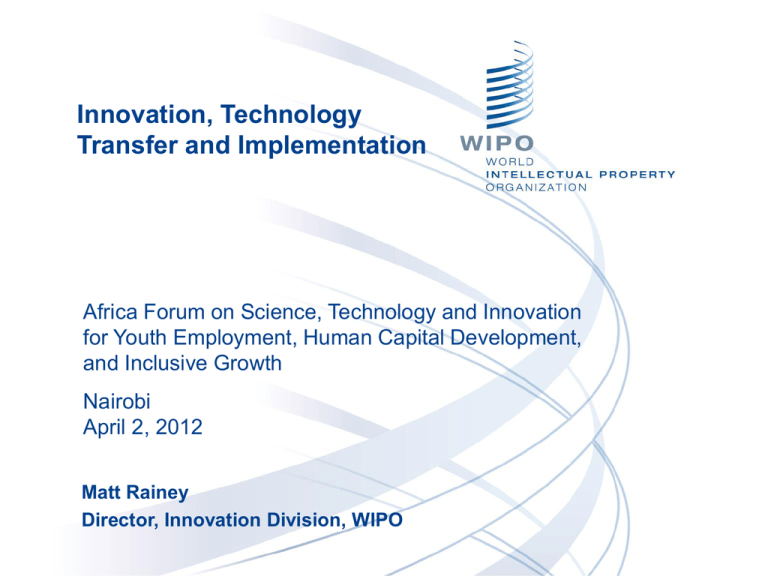
Innovation, Technology Transfer and Implementation Africa Forum on Science, Technology and Innovation for Youth Employment, Human Capital Development, and Inclusive Growth Nairobi April 2, 2012 Matt Rainey Director, Innovation Division, WIPO 2 WIPO’s Innovation Division – People International Staff fluent in 13 languages Various backgrounds and professional experience Private enterprises Legal Technical Government Diplomatic 3 Phases of Innovation: WIPO Training WIPO provides training and capacity-building throughout the phases of innovation: Conception Selection Prototypes Implementation (with refinements) Dissemination (Products, Knowledge) 4 Models of Innovation: Traditional (“Closed”) Innovation Prevailing model of innovation in economy based on manufacturing industry Centrally conceived and implemented Single entity R&D Lab Company Start-up Sole inventor 5 Models of Innovation: Networked (Open) Innovation “Open Innovation” (= Networked Innovation) Innovative contributions from multiple sources Responds to needs of knowledge-based economy Accelerates dissemination of know-how Not the knowledge you have Rather: network to obtain the knowledge you need Particularly suited to young professionals 6 WIPO Technology Transfer and Innovation Tech transfer entities that WIPO works with: Universities Research institutions Private sector entities Individuals International organizations Governments IGOs (Intergovernmental organizations) NGOs (Nongovernmental organizations) 7 Technology Transfer and Innovation – WIPO Resources and Training National economic strategy IP infrastructure IP laws and regulations IP education Institutional infrastructure IP Offices Licensing infrastructure (governmental and private) Technology management infrastructure TTOs, technology incubators, industrial parks, etc. Dispute resolution and enforcement WIPO Arbitration & Mediation Center 8 Technology Transfer – Legal Elements Convert Innovation to Implementation Institutional innovation ecosystem based on IPR management institutional policies Should be aligned with the national IP/Innovation strategy Issues IP ownership of the research results IP management procedures – disclosure, protection, development, IP valuation, marketing, commercialization Development and management of IP portfolio Standard models of agreements Benefit sharing Conflicts of interest 9 WIPO: the Global Technology Database PATENTSCOPE: www.wipo.int/pctdb/en/ Rich knowledge source Patent landscapes on many topics HIV vaccines Water desalination Solar cooking Malaria prevention and treatment Essential medicines in developing countries Etc. 10 WIPO-Sponsored Knowledge Sources ASPI: Access to Specialized Patent Information http://www.wipo.int/aspi/en/ Public-private partnership between WIPO and leading patent info providers For IP offices, academic institutions and research organizations in developing countries Free or low-cost access to sophisticated tools and services for retrieving and analyzing patent data ARDI: Access to Research for Development & Innovation http://www.wipo.int/ardi/en/ Increase availability of ST info in developing countries 11 WIPO Research and Training TISCs: Technology and Innovation Support Centers http://www.wipo.int/patentscope/en/programs/tisc/ In 65 countries (often in IP offices) Access to online patent and non-patent (scientific and technical) resources Access to industrial property-related publications Assistance in searching and retrieving technology information Training in searching databases On-demand searches (novelty, state-of-the-art, infringement) Technology and competitor monitoring 12 WIPO Research and Training (cont’d) IP laws Management and strategy Technology commercialization and marketing 13 WIPO Tech Transfer Publications “IP Asset Management Series” Application of IP asset management principles and methods in the context of proactive public policies 14 WIPO IP Asset Management Series Available at http://www.wipo.int 15 WIPO IP Asset Management Series Study on how IP can contribute to economic growth in ASEAN countries Recommendations focused on: IP strategic plans Development of IP professionals Promotion of licensing and commercialization Financial initiatives Potential benefits for region to explore the creation of an ASEAN Regional Network with participation from universities, R&D centers and other IP-related institutions Available at http://www.wipo.int 16 WIPO IP Asset Management Series Objective Fill the critical shortage of persons skilled in drafting patents in developing counties Target audience Scientists, researchers, technology managers, inventors and attorneys who will be drafting patent applications Key deliverable Clear understanding of patent scope, including claims Understanding structure of patent documents and patent application procedures Determining what, when, how and where to patent Claim designing and drafting skills Available at http://www.wipo.int 17 WIPO IP Asset Management Series 4-5 day two-part program Theoretical Simulation of licensing negotiation Key goals: create synergies and promote networking 3 levels: Basic, Advanced and “Training of Trainers” Available in Arabic, Chinese, English, French, Portuguese, Romanian, Russian, Serbian, Spanish, Vietnamese New Editions in Preparation: Sustainable and Evolving Subject matter is area of substantial collaboration between WIPO and professional regional and international associations (LESI, AUTM, ASTF, etc.) Available at http://www.wipo.int 18 WIPO IP Asset Management Series New publication for late 2012: Intellectual Property Policies and Technology Transfer Procedures for Universities and Research and Development Institutions Structured around 10 key critical issues for IP asset management, protection and commercialization Practical guide for: Issues in institutional IP policies Issues in organization of technology transfer offices IP and technology management procedures for R&D operations Issues in technology transfer and commercialization of technology and R&D results Training program 19 WIPO Training for R&D Networks & IP Hubs Model developed by WIPO and 10 partner institutions Key elements Fosters scientific collaboration Improves technical results Optimizes resource allocation Leverages economies of scale Reduces costs of research and IP protection, management and commercialization Has been implemented in the health R&D sector of 7 countries Colombia 6 West African countries: Cameroon, Central African Republic, Chad, Equatorial Guinea, Gabon, Republic of Congo 20 R&D Networks & IP Hubs 21 Some countries where WIPO has implemented capacity-building programs Europe Arab Countries Central and Latin America Asia Pacific Africa 22 Africa • ARIPO • Namibia • CEMAC • Nigeria • Cameroon • OAPI • Ethiopia • Rwanda • Ivory Coast • Senegal • Kenya • South Africa, • Madagascar • Zambia • Mauritius • Zimbabwe • Mozambique • Uganda Back to the map 23 Arab Countries • Algeria • Bahrain • Dubai • Egypt • Jordan • Morocco • Oman • Saudi Arabia • Syria • Tunisia Back to the map 24 Asia Pacific Region • China • India • Indonesia • Kyrgyzstan • Malaysia • Philippines • Singapore • South Korea • Sri Lanka • Thailand • Vietnam Back to the map 25 Europe • Croatia • FYR of Macedonia • Hungary • Italy • Lithuania • Serbia • Slovenia • Spain, • Turkey • Ukraine Back to the map 26 Central and Latin America • Argentina • Ecuador • Barbados • Jamaica • Brazil • México • Chile • Panama • Colombia • Peru • Costa Rica • Trinidad Tobago • Cuba • Uruguay • Domenican Republic Back to the map 27 Establishment of TTOs in Arab Region 28 Establishment of TTOs in Arab Region WIPO has developed project in response to request by five Arab region countries Algeria, Egypt, Jordan, Morocco, Tunisia Objective: Assist developing countries to create innovation infrastructure to support university-industry collaboration Features: Commercialize fruits of research Build connections with & within private sector “Convert” lab research into companies and jobs Particularly benefits professional graduates 29 Establishment of TTOs in Arab Region Funding Jordan: discussing with Islamic Development Bank Others: discussing with AfDB Flexible framework – adjustable to needs of individual countries Each country “owns” its operation 30 Establishment of TTOs in Arab Region Key operations Transfer of knowledge Setting up infrastructure Creating intermediaries able to facilitate innovation and technology transfer Two parts Country-specific projects Arab region innovation network Innovation partnerships and networks national, regional and interregional Networked innovation model of regional collaboration Duration 26 months in each country 38 months for entire region 31 Establishment of TTOs in Arab Region – Project Partners Core Project Partners – parties of the Framework Project Agreement Governments of participating countries Donor partners Arab Science and Technology Foundation (ASTF) WIPO (as executive agent) Other Partners Potential contributors with expert experience in relevant areas Professional associations Scientific foundations Private sector Financial institutions NGOs International organizations Other partners 32 Establishment of TTOs in Arab Region Status 2010: WIPO met with all 5 countries and development partners (including AfDB) in Tunisia 2011: Project submitted by countries to AfDB Project document later submitted to AfDB WIPO continues its discussions with AfDB Project partners (4 African countries) are hopeful of support 33 Next Steps Using WIPO Resources TISCs, R&D Hubs Can become elements of worldwide networks Ongoing training Patent analysis Licensing Know-how Implementation TTOs in Arab Regions Can be replicated elsewhere in Africa Thank you Matt Rainey Director, Innovation Division, WIPO matt.rainey@wipo.int
